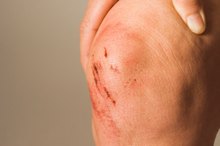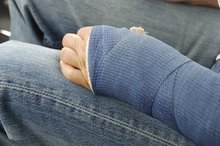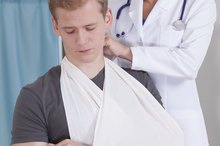What does fact checked mean?
At Healthfully, we strive to deliver objective content that is accurate and up-to-date. Our team periodically reviews articles in order to ensure content quality. The sources cited below consist of evidence from peer-reviewed journals, prominent medical organizations, academic associations, and government data.
The information contained on this site is for informational purposes only, and should not be used as a substitute for the advice of a professional health care provider. Please check with the appropriate physician regarding health questions and concerns. Although we strive to deliver accurate and up-to-date information, no guarantee to that effect is made.
Types of Physical Therapy for a Broken Arm
A broken arm can occur when any one of the three bones that make up your arm, the radius, ulna and humerus, are broken as a result of trauma 2. The most common cause of the condition is falling down and trying to break your fall by sticking out your arm. Recovery from a broken arm bone can take anywhere from a few weeks to over a month, depending on the type of break and the specific location of your injury 2. Following a period of immobilization to help your bone heal, your doctor is likely to prescribe physical therapy to help your arm return to its previous condition.
If you are experiencing serious medical symptoms, seek emergency treatment immediately.
Strength Training
You may have had to keep your arm in a cast for several weeks following your break, and after your cast is removed you may notice a loss of strength in your limb. Strength training is likely to include exercises designed to help restore muscular strength to your arm. These exercises are likely to include bending and straightening your arm under resistance as well as internal and external rotation to help restore strength to your shoulder joint. Be sure that you perform these exercises exactly as prescribed in order to recover as quickly as possible.
- You may have had to keep your arm in a cast for several weeks following your break, and after your cast is removed you may notice a loss of strength in your limb.
- These exercises are likely to include bending and straightening your arm under resistance as well as internal and external rotation to help restore strength to your shoulder joint.
Flexibility Training
Recovery & Rehabilitation Time for Shoulder Surgery to Remove Bone Spur
Learn More
Like the strength training exercises listed above, range of motion exercises are probably going to be prescribed to help restore full movement to your arm. The initial exercises are likely to be a bit painful, since your arm has probably been in a cast for several weeks. These exercises will include turning your hand up and down while keeping your elbow stationary, exercises to restore the movement of your elbow joint and even some exercises to restore movement to your shoulder joint.
Occupational Therapy
Depending on your specific job, therapy for a broken arm may include exercises designed to get you ready to return to work 2. These exercises can include manual manipulation of small parts, lifting exercises that mimic movements made during your work day and exercises that help strengthen specific muscles you use at work.
Sport Specific Therapy
Rehabilitation for a Broken Kneecap
Learn More
If you’re an athlete, your doctor may prescribe physical therapy to help you speed your return to the playing field. Depending on your sport and your specific injury, these exercises can include throwing motions, catching exercises and exercises designed to help restore your hand-eye coordination. The specific types of exercises depend greatly on your chosen sport and your specific injury, however.
Related Articles
References
- American Academy of Orthopaedic Surgeons: Distal Radius Fracture
- MayoClinic.com: Broken Arm
- Page P. Current concepts in muscle stretching for exercise and rehabilitation. Int J Sports Phys Ther. 2012;7(1):109-19.
- Yeun YR. Effectiveness of massage therapy on the range of motion of the shoulder: a systematic review and meta-analysis. J Phys Ther Sci. 2017;29(2):365-369. doi:10.1589/jpts.29.365
- Guide to Physical Therapist Practice 3.0. Alexandria, VA: American Physical Therapy Association; 2014.
- Dowell D, Haegerich TM, Chou R. CDC Guideline for Prescribing Opioids for Chronic Pain — United States, 2016. Recommendations and Reports. 2016;65(1);1–49.
- Guide to Physical Therapist Practice 3.0. Alexandria, VA: American Physical Therapy Association; 2014. Available at: http://guidetoptpractice.apta.org/.
Writer Bio
Keith Strange spent more than a decade as a staff writer for newspapers in the southeastern United States, winning numerous awards for his work. He has a B.S. in wellness/sports medicine from Averett University and completed graduate work in exercise physiology. Strange is a former competitive martial artist and holds a third-degree black belt in tae kwon do.









